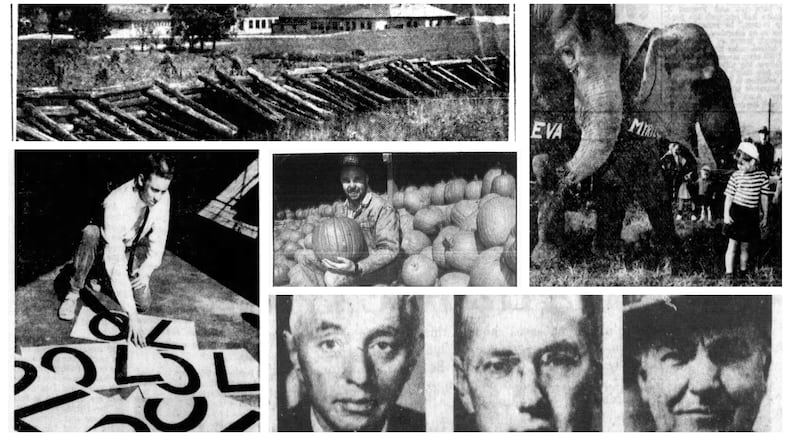Here’s a look at some stories from the week of Sept. 29-Oct 5.
Oct. 1, 1933: Auto, motorcycle race track to be built in Dayton
Dayton was to become an auto and motorcycle racing center, according to an announcement by the newly incorporated Dayton Speedway Corp.
The corporation planned to break ground on the $12,000 dirt track, five-eighths of a mile long. It was to be the only five-eighths track around, with half-milers in Hamilton Winchester and Greenville.
The track was to be located on West Carrollton Road, just off Germantown Pike.
Paul Ackerman, secretary of the Dayton Automobile Club and vice president of the Dayton Speedway Corp., said races would be sanctioned by the American Automobile Association.
Substantial purses were to be offered to attract the best racing talent in the country. Races were to start about April 1, 1934.
Sept. 30, 1943: Ringling Circus in Dayton for two days
Boys and girls gazed in wonderment as the Ringling Brothers and Barnum & Bailey circus unloaded 70,000 tons of gear and erected a new all-white, six-pole “big top” tent at the Montgomery County Fairgrounds.
The “big top,” with three rings and two stages, could seat 14,500 people.
The circus was in town for afternoon and evening performances over Thursday and Friday that week.
That season’s performance opened with a nostalgic spectacle which turned back the clock to reproduce a circus street parade of 1898, featuring a 30-piece band.
A tribute to the United Nations was to be paid by the entire circus personnel of 1,600 in a performance called “Let Freedom ring.”
Other performances were to include a promenade of 50 elephants, an aerial ballet of 60 girls, dancing stallions, jitter-bugging unicyclists, wild animals, daredevils of the high wire, bareback riders and a horse ballet.
Sept. 29, 1963: 70 mph speed limit becomes legal
The speed limit on Ohio expressways was a day away from going to 70 mph, but not without serious misgivings from highway patrol officers.
Sgt. Roger Wilson, who headed Dayton’s State Highway Patrol, cited excessive speed as the leading cause for crashes.
In those days, I-75 ended at West Carrollton and became U.S. Route 25 through Dayton and northern Montgomery County. It became I-75 again at the Miami County line.
The worry was that motorists, accustomed to expressway speed, might not slow down when driving through Dayton.
“We’ve made 100 arrests this month,” Wilson said. “Friday nights are the busiest when the through traffic is heavier.”
Unconcerned was Col. Scott Radcliffe, superintendent of the state patrol. He termed the new 70 mph limit “a little more realistic for expressways.”
Oct. 2, 1983: Dayton hall of fame to enshrine inventors
Dayton’s Engineering and Science Hall of Fame was set to install Adm. Hyman Rickover, Dr. Charles H. Townes and the late Thomas Edison as its 1983 selections.
Rickover and Townes were scheduled to attend the enshrinement ceremony, which was held at the Dayton Marriott Hotel. The master of ceremonies was Hugh Downs, host of ABC News’ 20/20 television program.
Edison, a native of Milan, Ohio, developed the first uses of electricity, including the electric light. He was also the father of the phonograph and numerous other inventions.
Rickover is best known as the father of the U.S. Navy’s atomic submarine program. His work led to the completion in 1954 of the Nautilus, the world’s first atomic submarine.
Townes received the Nobel Prize for his work in the development of the laser and of the maser, a similar device that operates at microwave frequencies.
Hugh Hildebrant, president of the hall of fame, noted that it was established in Dayton after it was discovered “there was no national organization to recognize the world’s top engineers and scientists, past and present.”
Oct. 3, 1993: Pipsqueaks and giants in Dayton-area pumpkin yield
Although many of the pumpkins grown in patches in Ohio that fall had proved to be on the smaller side, Dayton-area growers were reporting plentiful supplies of near-normal size jack-o-lanterns.
Pumpkin prices ranged from 22 to 30 cents a pound.
It was the second year in a row that Ohio pumpkins had suffered due to weather. Late summer heat had the pumpkins ready too early in 1992. In 1993, drought-like conditions stunted pumpkin growth. Pumpkins grow best in dry weather on well-drained land.
“I’ve got tons of pumpkins and even though they’re about 20 percent smaller than they were last year, there are plenty in the popular 15- to 20-pound range,” said Jeff Wentworth, owner of Windmill Farm Market near Springboro.
Wentworth devoted 60 acres to pumpkins that year.
About the Author






